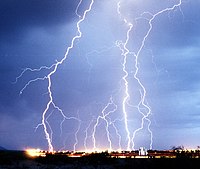
Photo from wikipedia
An integrated energetic particle transport model has been constructed in JET plasmas constrained by experimental fast ion loss measurements. The model incorporates a synthetic fast ion loss detector identical to… Click to show full abstract
An integrated energetic particle transport model has been constructed in JET plasmas constrained by experimental fast ion loss measurements. The model incorporates a synthetic fast ion loss detector identical to JET’s thin-foil Faraday cup fast ion loss detector array. The loss model combines analyses from the TRANSP and ORBIT-kick codes with enhanced features for producing the synthetic diagnostic. Extensions to the ORBIT code framework allow a full-orbit representation within the vacuum region that can map particles directly to an installed detector geometry. Since synthetic fast ion loss detectors are plagued by weak loss statistics, a novel reverse integration biasing scheme has been implemented to boost computational efficiency. The model is validated against experimental loss measurements induced by long-lived kink modes and is found to be in good agreement. This confirms the development of a fully integrated transport/loss model which can be quantitatively verified against experiment allowing for future validation and predictive studies. The model is particularly useful for more complicated plasma scenarios that involve multiple fast ion species such as JET’s 2021 DT-campaign.
Journal Title: Nuclear Fusion
Year Published: 2021
Link to full text (if available)
Share on Social Media: Sign Up to like & get
recommendations!